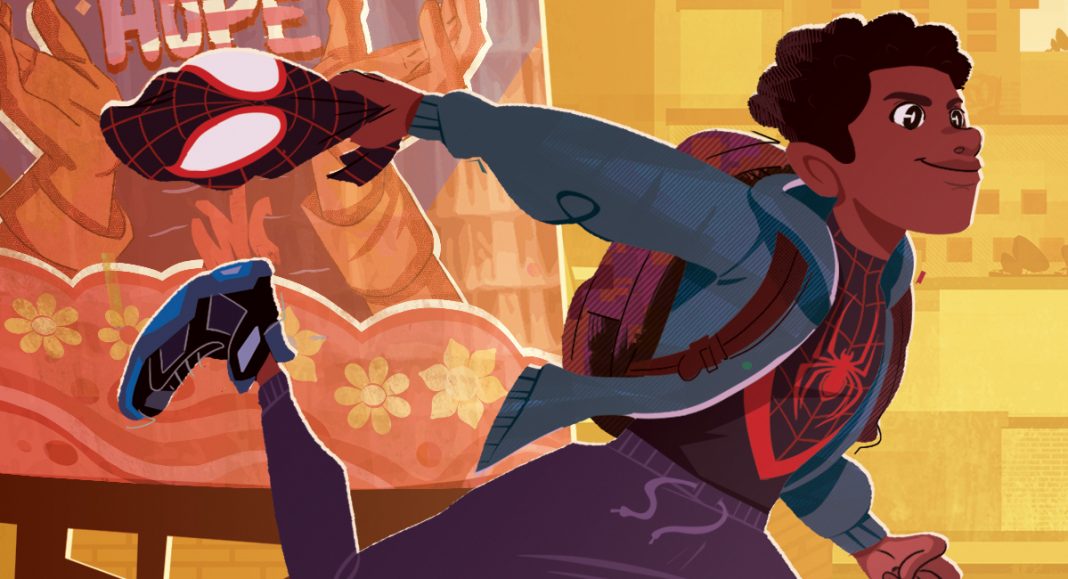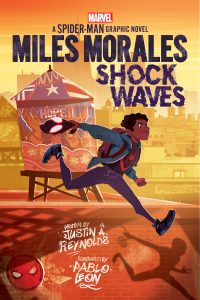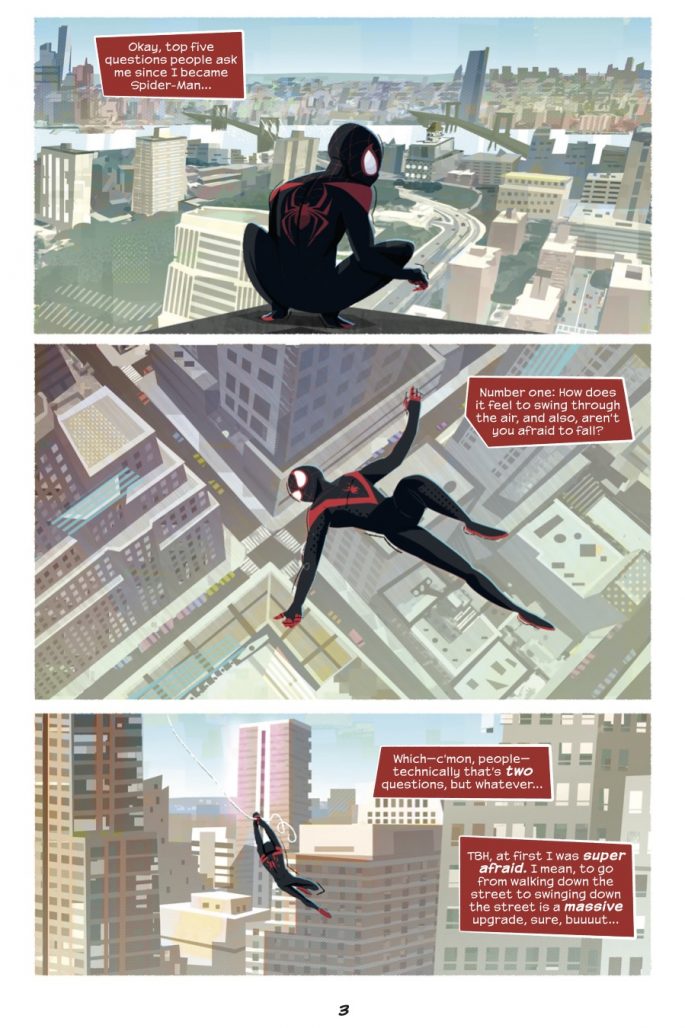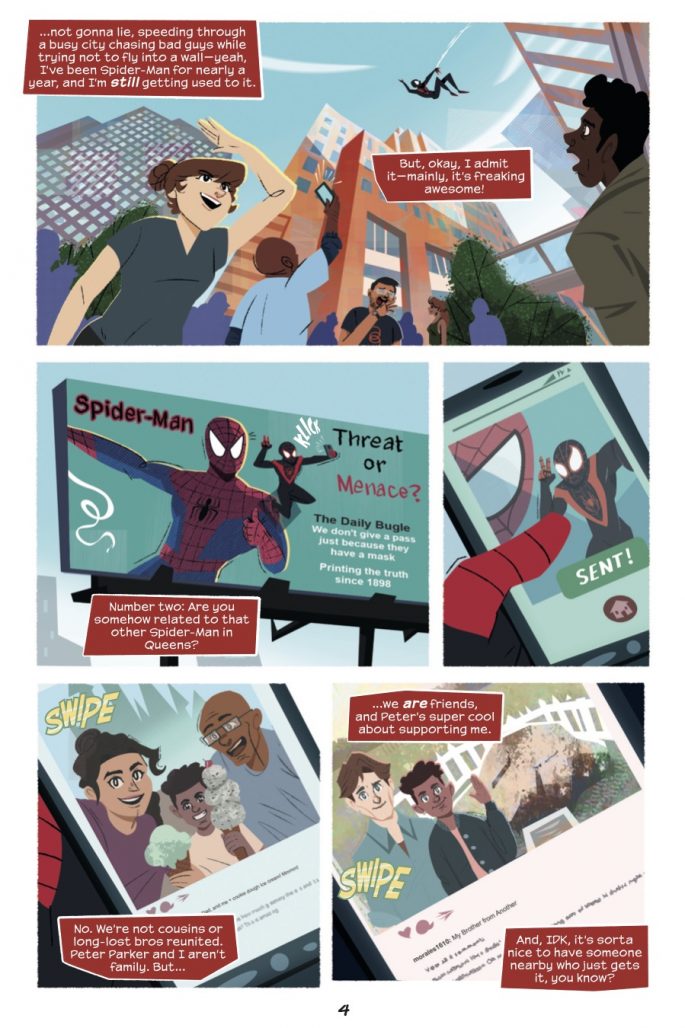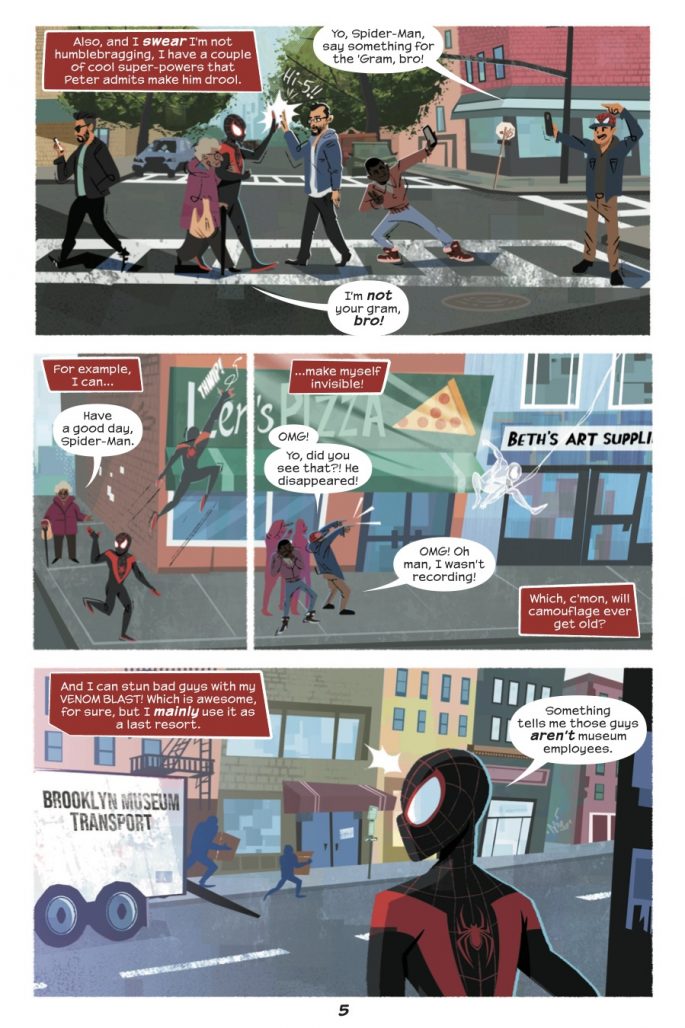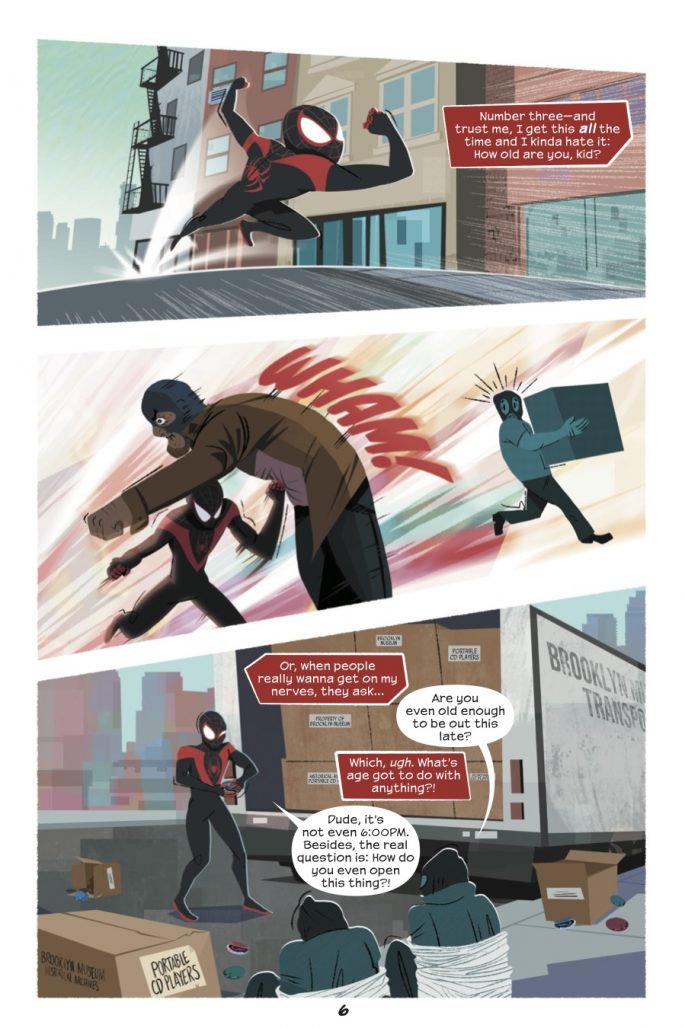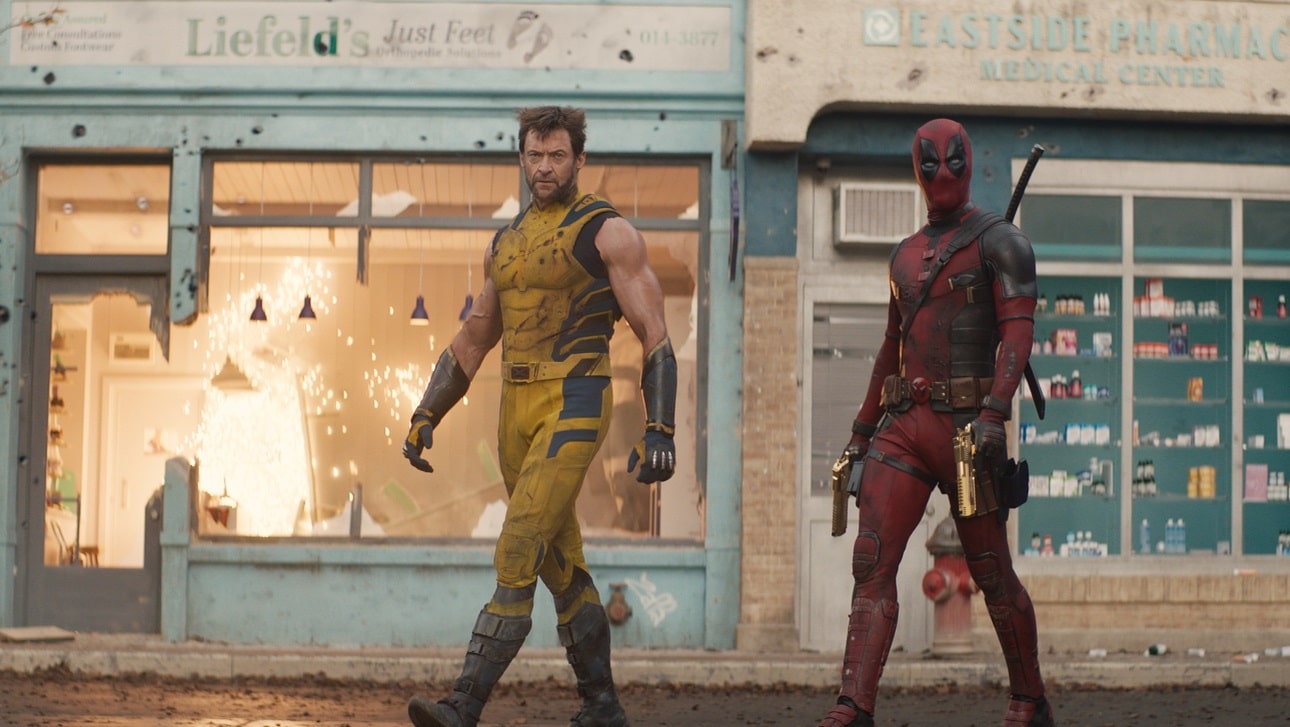Last year, Marvel and Scholastic announced a new partnership that would bring the iconic characters from the House of Ideas to a series of new young readers graphic novels published under Scholastic’s Graphix imprint. Next week sees the release of the first book under that deal, Miles Morales: Shock Waves, a middle-grade book that follows Miles as he makes new friends, faces new threats, and deals with the aftermath for his family of a devastating earthquake in Puerto Rico.
The graphic novel is the first from best-selling writer Justin A. Reynolds and Eisner-nominated artist Pablo Leon, who team with layout artist Geoffo and letterer Ariana Maher for the book. Reynolds and Leon took time to chat with The Beat about their work on Miles Morales: Shock Waves, the book’s ties to the larger Marvel Universe, and the importance of Miles’s Black and Puerto Rican heritage.
Joe Grunenwald: How familiar were both of you with Miles and his history before taking on this graphic novel?
Justin A. Reynolds: I was pretty familiar with Miles and his history. In fact, he was my dream Marvel character to work on, and honestly, it wasn’t something I saw happening in the immediate future. This whole experience has been amazing.
Pablo Leon: I was definitely not an expert. Like everyone else, a lot of my love for Miles comes from his treatment in the Into the Spider-Verse movie. I had read a couple of trades when he debuted and was part of the Ultimate universe years back, and I got more familiar with him with the original Spider-Verse comic storyline. I admit I have a hard time keeping up with universal resets or mergers, so I wasn’t sure of Miles’ place in the overall Marvel Comics universe, so when I was offered this opportunity, I picked up more recent storylines to get more familiarized with the character and its current direction.
Grunenwald: Were there any particular stories or influences, Spider-Man or otherwise, that you drew from while working on the book?
Reynolds: I really wanted to zero in on Miles’s family and home life. When you think of Peter Parker’s Spider-Man, most of his struggles are tied to juggling family and friends with the weighty responsibility of protecting the city—the same is true with Miles. I thought about the ways Peter’s succeeded and failed at striking that balance and reflected on how difficult that must be for a twelve or thirteen-year-old kid. It was also important to me to dive into Miles’s cultural heritage—his Puerto Rican and African American roots.
Leon: So obviously for me the strongest influence was the Spider-Verse movie. It had a great impact on me and it has been a very accessible portal for people to get into the Miles Morales universe. On a more traditional level, Miguel Covarruvias and Al Hirshfield are some of my biggest artistic influences. They use tangents smartly and purposely as an artistic choice, which is something I did a lot in this book.
Grunenwald: Shock Waves does a nice job pulling in aspects of Miles’s character and look from different places, whether it’s the comics or animation. How much freedom did you have in deciding which parts of Miles’s history and costume design you would incorporate?
Reynolds: The folks at Marvel were really great about giving me room to explore Miles in ways both known and unknown. Miles already has this very rich history and we just wanted to add to his legacy—to honor where he’s been and explore where he’s going.
Leon: I’m not a traditional comic book artist, especially when it comes to superhero comics, so my initial approach to this was to have a graphic, “kid lit” look, that would hopefully complement the story as best as it could. I thought we had a really nice opportunity to explore this look and our editor, Lauren Bisom, really went out of her way to give me as much room to experiment as possible early on, which honestly was fantastic. My background is in animation design, so of course I also dove into this with the Into the Spider-Verse style in mind. I didn’t want it to look exactly like the movie, but be recognizable enough so if that movie is your entry point, it feels welcoming.
I also went through the 2017 animated series – while it wasn’t my favorite depiction of Miles, it was very influential in the way they streamlined their designs and I tried to incorporate some of that wherever possible. Looking at it now, there are so many things I would have done differently, but I’m still happy with how it came out!
Grunenwald: There are a lot of little nods throughout the book to the larger Marvel Universe, from things drawn in the background of scenes to character cameos that people who know the Marvel U will immediately recognize. How did you decide how much of those sorts of things to include?
Reynolds: Honestly, I threw in a couple of suggestions but largely those were Pablo’s nods, haha. He’s so creative and thoughtful in his art, and it’s on full display in Shock Waves. Seriously, I’m still finding new easter eggs and few people have stared at these pages more than us.
Leon: It’s one of my absolute favorite things to do. I love adding as many little nods and stories in the backgrounds as possible. I wish I could give you a really deep reason, but honestly a lot of it is just me having a ton of fun. For my part, I had a lot of free range when it came to the Marvel Universe characters and symbols, as long as it didn’t cross into any other platforms or into other IPs, even if owned by the same company. For example, my initial Miles design was wearing a Mandalorian t-shirt. As cool as that was, it had to go, but it lives on in my hard-drive.
Grunenwald: I appreciate that this book has a focus on Miles’s Puerto Rican background. A lot of Miles stories seem like they focus more on his being Black than Hispanic. Why was highlighting that aspect of the character important to you?
Reynolds: It happened organically. I was paying close attention to the news at the time I was thinking about what story I might tell, and a series of earthquakes had just hit Puerto Rico, and seeing those images of those beautiful, resilient people rebuilding the island and their lives—it really hit hard. I wondered what Miles’s mom Rio would be feeling, how her family would be impacted. I thought about how that would affect Miles’s, learning of the devastation, and the fact that this is one “villain” he can’t defeat—this natural disaster. But of course, he comes up with other ways to help. I think Miles is lucky to have two strong parents who take immense pride in their rich cultural heritage. Miles is a great example of both the beauty and power of diversity and multiculturalism.
Leon: I personally love it. I know he means so much for so many Afro-Latines and Latines. I mean, identity is such a deep dive, but I’d love to know that at least one mixed kid out there picked this up and felt seen. To me, that’d be the big win. While we share some similarities, I’m not Puerto Rican, so I can’t speak for that specific Boricua experience, but I tried to add bits here and there that I felt someone could relate to, both from my experience growing up in a very Latino neighborhood in the East Coast as well as being Latino myself.
Grunenwald: What did you both enjoy the most about working with each other?
Reynolds: Pablo pushed me to tell the best story I could; every time I saw another one of his amazing panels, I was like, okay, back to work. It was fascinating watching him up close and personal, the way he paid attention to details, the questions he asked. Getting to know Pablo was an unexpected, awesome bonus.
Leon: I think Justin gave Miles a voice that feels authentic to the character and its world. He was passionate about the project and once we hit a point where we understood how each other worked, it was smooth sailing. Honestly that’s the best type of co-worker anyone can ask for.
Grunenwald: What are you excited for readers to see when they check out Miles Morales: Shock Waves?
Reynolds: I hope they see a Miles they recognize, story and art alike—but I also hope we added to his legend, even if just a bit. That we honored his humor, integrity, and empathy—all while letting him be a fun, though not-always-perfect, kid.
Leon: I think for a while there, things were getting a bit grim in the superhero world, so I’m very much enjoying this renaissance of heroes just being wholesome and relatable. I’m very much looking forward to kids having easy access to a really fun, feel-good story.
Published by Scholastic under the Graphix imprint, Miles Morales: Shock Waves arrives in stores on Tuesday, June 1st.


